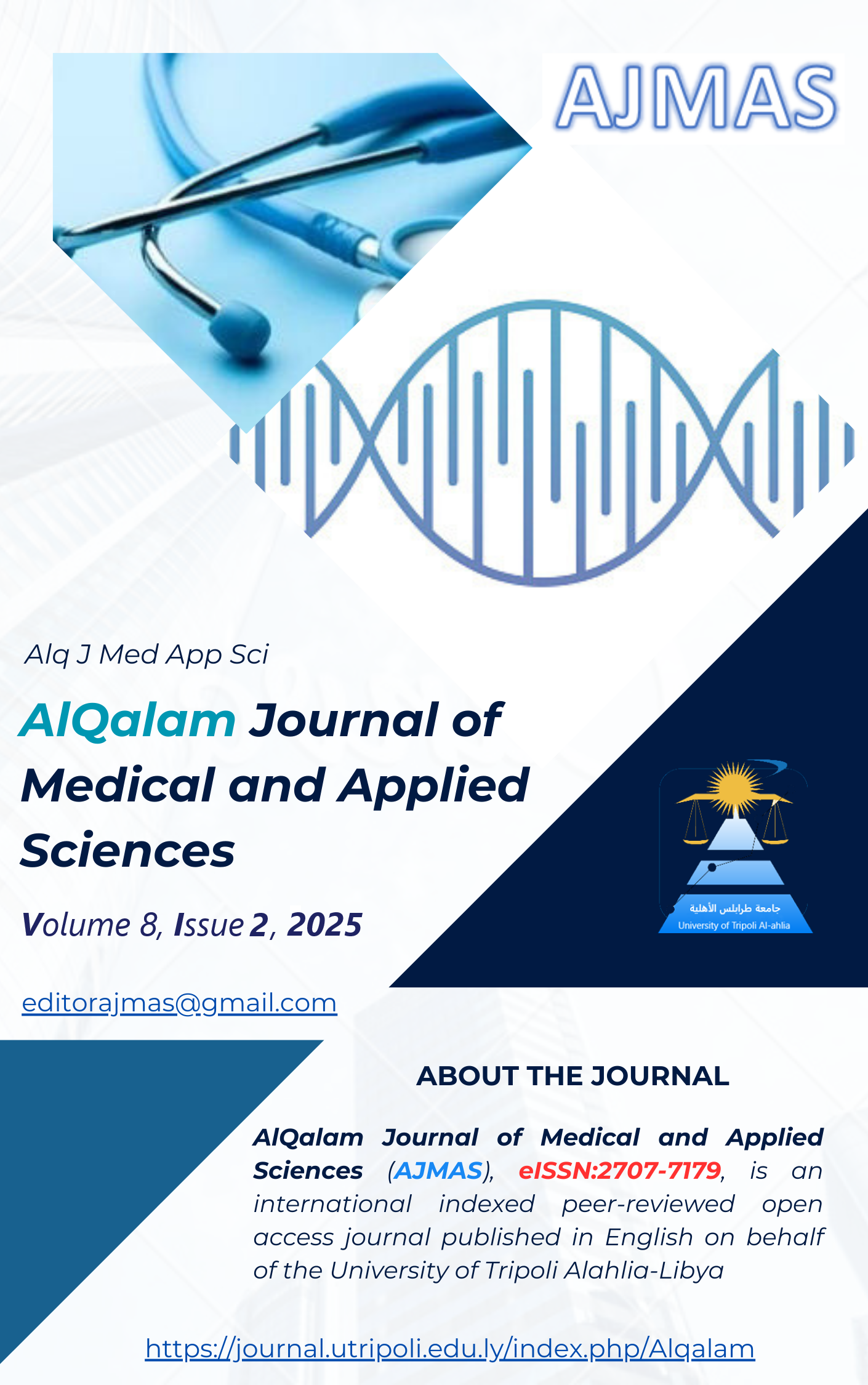Reference Interval for Uric Acid Among Libyan Healthy Individuals
DOI:
https://doi.org/10.54361/ajmas.258226Keywords:
Uric acid, Reference Intervals, Dichlorohydroxybenzene sulfonate, National Health and Nutrition Examination Survey.Abstract
The current study seeks to evaluate the possible risks that are related to the use of reference intervals (RIs) obtained from other populations in clinical chemistry analysis, with special reference to the Libyan population. Concerns stem from the significant disparities between the Libyan population and the reference populations, mainly concerning the lifestyle and genetic heritage. These inherent differences leave doubt on the generalizability of the above existing RIs to the Libyan population. The objective of this study is to establish the RIs of serum uric acid (UA) in the Libyan population; there has been no such study done before in Libya. In the present study, blood samples were freshly collected by venipuncture from 139 healthy females after explaining the nature of the study to them; the blood samples were collected aseptically into untreated tubes. After the centrifugation process for 15 minutes, the obtained serum specimens were analyzed through the spectrophotometric assay to determine the UA concentrations. The non-parametric percentile method was applied to establish the RIs of uric acid. The results showed that the number of values and the order of the value were 134.55 and the corresponding concentration is 7.4 mg/dl, and then the reference period is 2.7-7.4 mg/dl. The reference range of UA concentration as identified by this study is between 2.7 mg/dl and 7.4 mg/dl. These observed differences in RIs have implications for advocating the need to develop the RIs for the populations of different geographical locations. The RIs generated in this context are more relevant and fitting in the case of the Libyan population as compared to those mentioned in the manufacturing kit or those that can be sourced from other populations.
تسعى الدراسة الحالية إلى تقييم المخاطر المحتملة المتعلقة باستخدام الفواصل المرجعية المأخوذة من مجموعات سكانية أخرى في تحليل الكيمياء السريرية، مع التركيز بشكل خاص على السكان الليبيين. تنبع المخاوف من التباينات الكبيرة بين السكان الليبيين والمجموعات السكانية المرجعية، والتي تتعلق بشكل رئيسي بنمط الحياة والوراثة الوراثية. هذه الاختلافات الجوهرية تترك مجالًا للشك في إمكانية تعميم الفواصل المرجعية المذكورة أعلاه على السكان الليبيين. تهدف هذه الدراسة إلى تحديد الفواصل المرجعية لحمض اليوريك في المصل في السكان الليبيين؛ حيث لم تُجرَ أي دراسة من هذا القبيل في ليبيا من قبل. في هذه الدراسة، جُمعت عينات دم حديثة عن طريق بزل الوريد من 139 أنثى سليمة بعد شرح طبيعة الدراسة لهن؛ جُمعت عينات الدم بطريقة معقمة في أنابيب غير معالجة. بعد عملية الطرد المركزي لمدة 15 دقيقة، حُللت عينات المصل التي تم الحصول عليها باستخدام التحليل الطيفي الضوئي لتحديد تركيزات حمض اليوريك. طُبقت طريقة النسبة المئوية غير المعلمية لتحديد الفواصل المرجعية لحمض اليوريك. أظهرت النتائج أن عدد القيم وترتيبها كان 134.55، وأن التركيز المقابل هو 7.4 ملغ/ديسيلتر، وأن الفترة المرجعية تتراوح بين 2.7 و7.4 ملغ/ديسيلتر. يتراوح النطاق المرجعي لتركيز حمض اليوريك، كما حددته هذه الدراسة، بين 2.7 و7.4 ملغ/ديسيلتر. لهذه الاختلافات الملحوظة في مؤشرات الاستجابة المرجعية آثارٌ على الدعوة إلى تطوير مؤشرات استجابة مرجعية لسكان مختلف المناطق الجغرافية. وتُعدّ مؤشرات الاستجابة المرجعية المُولّدة في هذا السياق أكثر ملاءمةً وأهميةً لحالة السكان الليبيين مقارنةً بتلك المذكورة في مجموعة التصنيع أو تلك التي يمكن الحصول عليها من سكان آخرين
Downloads
Published
How to Cite
Issue
Section
License
Copyright (c) 2025 Fatima Al Majdoup

This work is licensed under a Creative Commons Attribution 4.0 International License.















